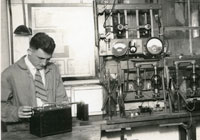
Malcolm Hanson was a university student described as Professor Earle M. Terry‘s ‘right hand man’ in the development of WHA. Indeed, Hanson was absolutely central to WHA’s broadcasting success.
In 1918 all radio stations were ordered to dismantle because of WWI, but 9XM was permitted to maintain its equipment to continue experimental transmissions between Madison and the U.S. Naval Training Station in Great Lakes, IL, where Hanson was training as a naval soldier. If Hanson had not been involved with the Great Lakes base, it is unclear if Madison would have been among the few stations granted the freedom to further develop radio technology.
Little information remains about Hanson, but the archives point to an almost cinematically varied and colorful life. Hanson first became involved with 9XM in spring of 1915, helping Terry with the construction and everyday operations of the transmitter including Terry’s famous glass blowing sessions. Hanson was so astute at radio construction that he developed a ‘crystal set’ that later was manufactured and sold by Burgess Laboratories. In 1917 he entered the navy, but returned to Madison after the War and stayed on as a station manager until 1924. All reports point to Hanson as a precocious and dedicated student of radio science, and soon after he returned to Madison, telephonic broadcasting was achieved by the station in November of 1920. After 1924 Hanson left the university to reenter the navy as a radio engineer.
Serendipitously, one of his naval assignments was to install radio equipment for Admiral Byrd’s North Pole expedition. The ships were due to clear port for Norway on the first leg of the trip before Hanson’s work was done, and Hanson was to be redeployed from a Norwegian base. He requested to go along with Byrd but navy officers wouldn’t permit it. So Hanson solved the problem by stowing away on the ship and appearing after the ship was at sea to finish the installation. With a ‘gratified wink’ the admiral rebuked Hanson for going AWOL, but was impressed by Hanson’s tenacity. When Byrd was outfitting his next expedition—his first trip to the South Pole—he sought out Malcolm Hanson as the man he wanted to take along to be in charge of radio short-wave communications.
Hanson built all of the gear himself and accompanied the legendary 1928 expedition for 14 months in Antarctica. Upon returning he won the gold medal award from the Veteran Wireless Operators Association. Hanson later served on ‘secret missions’ for the US government in London until WWII, when he was promoted to the position of Commander. Sadly, Hanson died in plane accident in Alaska during the second world war.
Hanson’s archival legacy is sparse but includes a letter detailing his life written to his mother, a self-published text with a brief biography of Hanson’s life through his correspondence, several dozen significant photographs of the early 9XM transmitter experiments, some newspaper clippings, and miscellaneous documents pertaining to WHA.
Digital Documents
Honorary diploma from UW Madison
Related Links
